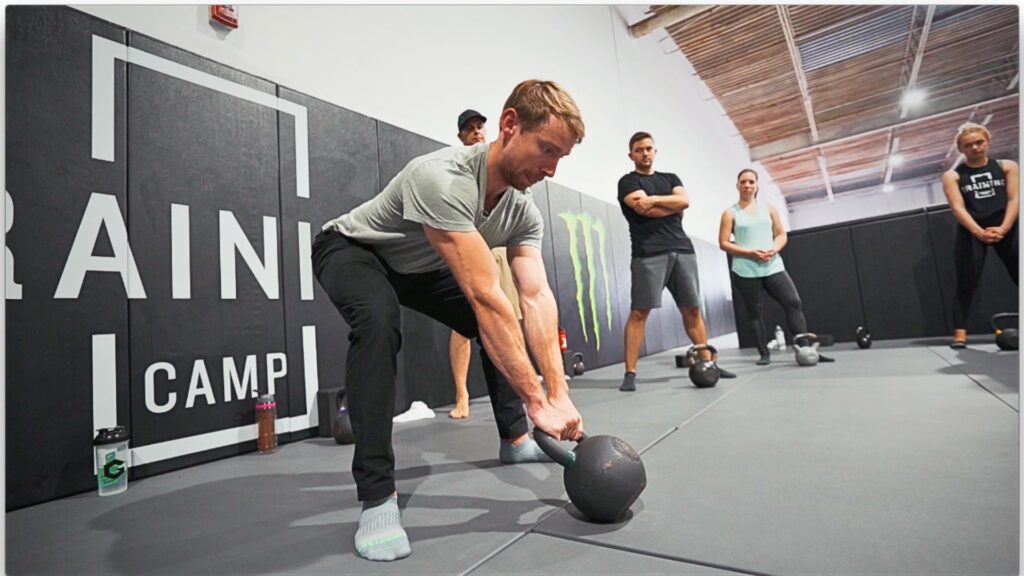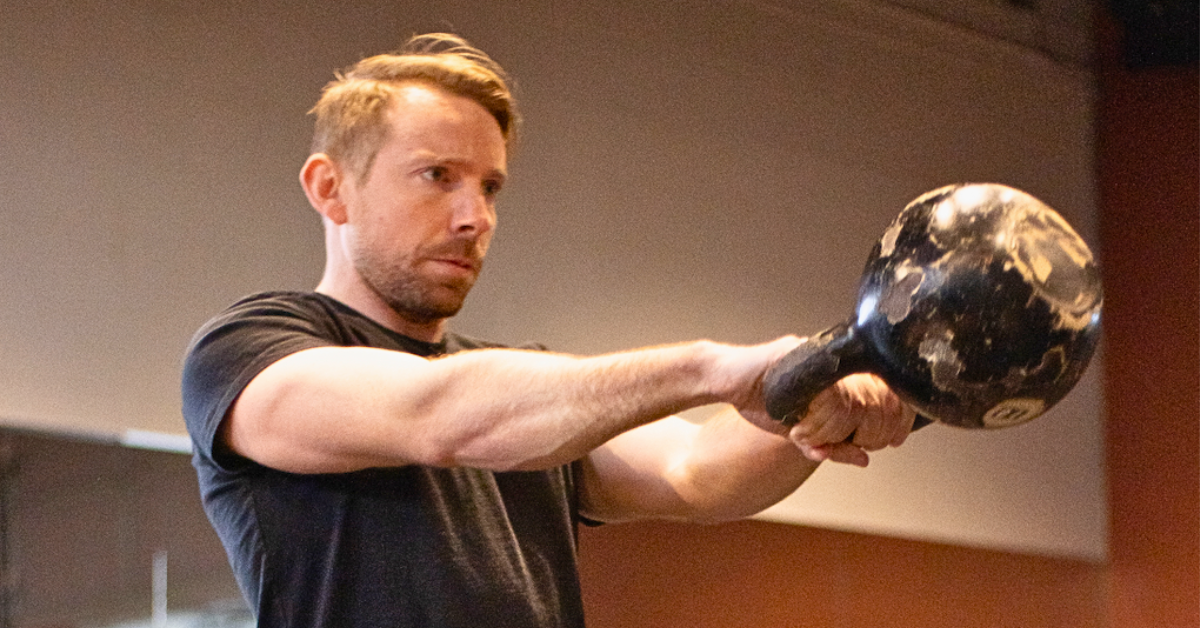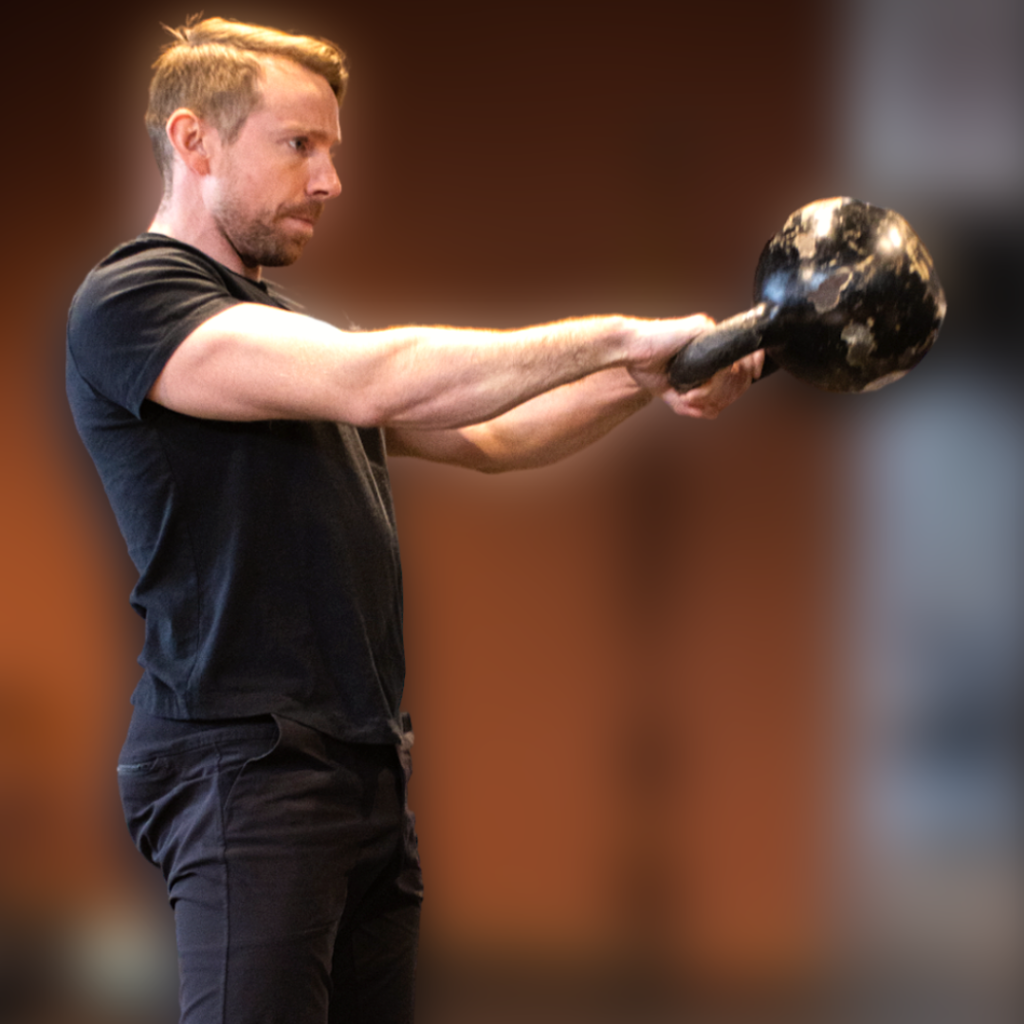“The swing is a fat-burning athlete builder.” – Dan John
The dynamic full-body workout you get from kettlebell swings is unbeatable.
Power, strength, cardio… it’s all here (and then some).
The kettlebell swing is pretty close to a perfect exercise with its mix of dynamic power, total-body engagement, and fluidity.
Whether you’re a fitness enthusiast looking to take your performance to the next level or a total newbie hoping to get started right, the swing will set you on the right path.
In this comprehensive guide, we will delve into the mechanics, benefits, and step-by-step techniques required to master the art of the kettlebell swing.
Kettlebell Swing Muscles Worked
What muscles get worked in the kettlebell swing?
Most of ‘em.
Especially when you perform your swings the way I’m going to teach you.
The swing is a hip hinge exercise and the prime movers include the posterior chain muscle groups of the hamstrings, glutes, spinal erectors, lats, and upper back.
You’ll also get tremendous activation in the quadriceps, core, chest, and arms as well.
The kettlebell swing is renowned for its exceptional ability to improve cardio endurance.
The high-intensity, explosive nature of the move quickly spikes the heart rate, as your heart and lungs work harder to deliver oxygen-rich blood to the working muscles. This consistent demand on the cardiovascular system gradually increases its capacity to efficiently transport oxygen and nutrients, leading to improved endurance over time.
Moreover, the repetitive and dynamic nature of kettlebell swings promotes a steady flow of blood and oxygen, resulting in heightened lung capacity, enhanced VO2 max (the maximum amount of oxygen your body can utilize during exercise), and an overall improved ability to sustain physical activity for extended periods.
This unique combination of explosive movement and continuous effort makes kettlebell swings an outstanding choice for individuals seeking to elevate their cardio endurance levels.
Learning the Kettlebell Swing
I’ve taught hundreds of clients how to swing a kettlebell over the years.
Some athletes pick it up on the first try.
But most folks need to work through a series of progressions to get it right.
While the swing itself is relatively simple, there are tons of details involved in optimizing for both performance and safety.
Unlike many exercises, you can’t simply stop in the middle of a rep to correct a mistake.
Once you start swinging, any adjustments have to be made on the fly. That’s why it is absolutely crucial to have a clear understanding of the swing and a step-by-step method to work up to it.
Now let’s take a look at the sequence I take new clients through to make the learning process as seamless and efficient as possible.
Step 1 – The Kettlebell Deadlift
The deadlift is the fundamental loaded hip hinge movement.
And it just so happens that deadlifting with a kettlebell is the best way to learn this pattern (as opposed to a barbell) thanks to the design of the kettlebell itself.
How to perform the kettlebell deadlift:
- Stand over the bell so your ankle bones line up with the handle
- Place your heels about hip-width apart, toes turn slightly out
- With a neutral spine, fold forward and push the hips back, getting a good stretch in the hamstrings
- The knees will bend but try to keep the shins vertical
- The feet remain rooted and balanced with equal pressure through the big toe, little toe, and heel.
- Once you reach the handle, stiffen the triceps to keep the arms straight and pull the shoulders down (not back) to properly engage the lats
- Squeeze the glutes to extend the hips and the knees will naturally straighten out
- Stand tall with total body engagement, being mindful not to lean back and hyperextend
- Fold forward, push your hips back, and return the bell to the ground.
- Keep your gaze on the horizon at all times. This will naturally have you looking slightly up at the bottom and straight ahead at the top
Step 2 – The Kettlebell Belly Hinge
Now that you’ve mastered the deadlift, the belly hinge will fine-tune your engagement of the posterior chain and improve your ability to engage the core.
Anatomically, the belly hinge looks almost identical to the deadlift (and the swing). The difference lies in where and how you hold the kettlebell:
- Grip the horns of the kettlebell handle (much like a goblet squat) and push the bottom of the bell into the top abdominal area
- Inhale through the nose and brace the abs against the kettlebell
- Hinge the hips as above
Think of the arms as performing an isometric row. The elbows actively drive back while the shoulders pull down with the lats.
Taken together, this core and upper back engagement keeps the spine in strong safe alignment.
Step 3 – The Drag Deadlift
Now we add horizontal movement with the drag deadlift.
The role of the lats in the swing cannot be overstated and this deadlift variation teaches you how to use the lats in order to control the kettlebell.
- Stand at arm’s length away from your bell
- Hinge the hips, reach out to grab the handle, and tip the bell towards you
- Grip tight and drag the kettlebell towards you using just the lats
- Keep pulling until the bell reaches the original deadlift start position
- If you continue to really flex through the lats and triceps, the kettlebell might even float up off the ground

Step 4 – The Kettlebell Hike Pass
Now we’ll add some ballistic intention (fast movement) with the hike pass.
The kettlebell hike pass is essentially the faster, flying version of the drag deadlift.
The goal here is to take the kettlebell from the ground to the backswing position (outer forearms connected to inner thighs).
- Set up in the drag deadlift stance
- Use the lats and triceps to pull the kettlebell off the floor and push it back past the groin
- Stay in a deep hinge stance and be careful not to raise the hips
- Allow the kettlebell to passively swing back to the starting position
The hike is how you’ll load the hips for the kettlebell swing. It’s like pulling back the bow string before launching the arrow.
Getting a consistent hip hinge and hike pass is half the battle of nailing the perfect swing.
Step 5 – The “Yang” Plank
The top of every kettlebell swing includes a tall standing posture with the entire body locked out strong.
To dial in this feeling, we’re actually going to step away from the kettlebell for a minute and practice the yang plank.
- Set the feet about hips width apart and hands close. This approximates the stance at the top of a kettlebell swing
- Drive the heels back, flex the quads, glutes, and abs tight
- Stiffen the triceps and pull the shoulders down to engage the lats
- Hold for 10-15 seconds
At this point you should be shaking from the tension but stay relaxed in your face.
This is what you want to feel at the top of every kettlebell swing!
Step 6 – The Dead-Stop Kettlebell Swing
Now that we’ve dialed in the hike pass and lockout, all that’s left is to extend the hips and launch the kettlebell.
We bring everything together with the dead stop kettlebell swing.
Basically you will perform a swing one rep at a time – returning the kettlebell to the ground between each rep.
- Set up for the hike pass as above
- Once the bell is high into the backswing, squeeze the glutes and stand straight up
- Brace the core and engage the quads by thinking about pulling your kneecaps up to the groin
- Allow the kettlebell to float anywhere between belly and chest height
- Keep the triceps engaged to maintain straight arms, but do not lift the kettlebell with the shoulders
- As the bell falls, guide and push it back into the hips with the lats
- Use that lat and tricep strength to decelerate the bell and return it back to the ground
Step 7 – Continuous 2-Hand Kettlebell Swings
Once you dial in the swing for single reps, you can start stringing them together for 5-10 reps at a time.
Cyclical swings are performed with all the same basic techniques you’ve learned up to this point.
Instead of resting the kettlebell between each rep, simply continue the hip hinge and extension for the desired number of reps.
On your last swing, catch the kettlebell into the backswing to decelerate, park it, and rest.
Conclusion
Now you have a proven set of progressions and techniques to lean on in your quest for the perfect kettlebell swing.
Remember, consistency and proper form are key to reaping the full benefits that kettlebell swings have to offer. So practice them often.
Whether you’re looking to enhance your cardiovascular endurance, strengthen your muscles, or simply inject variety into your workouts, you now have the kettlebell swing in your arsenal. By incorporating the techniques, safety guidelines, and tips outlined in this guide, you’re on the path to achieving remarkable results and a stronger, more resilient you.
PS – If you want to take your kettlebell training to the next level, check out the Kettlebell Foundations online course.
PPS – Use coupon code “kb25” to get 25% off now through September 1st 😉

